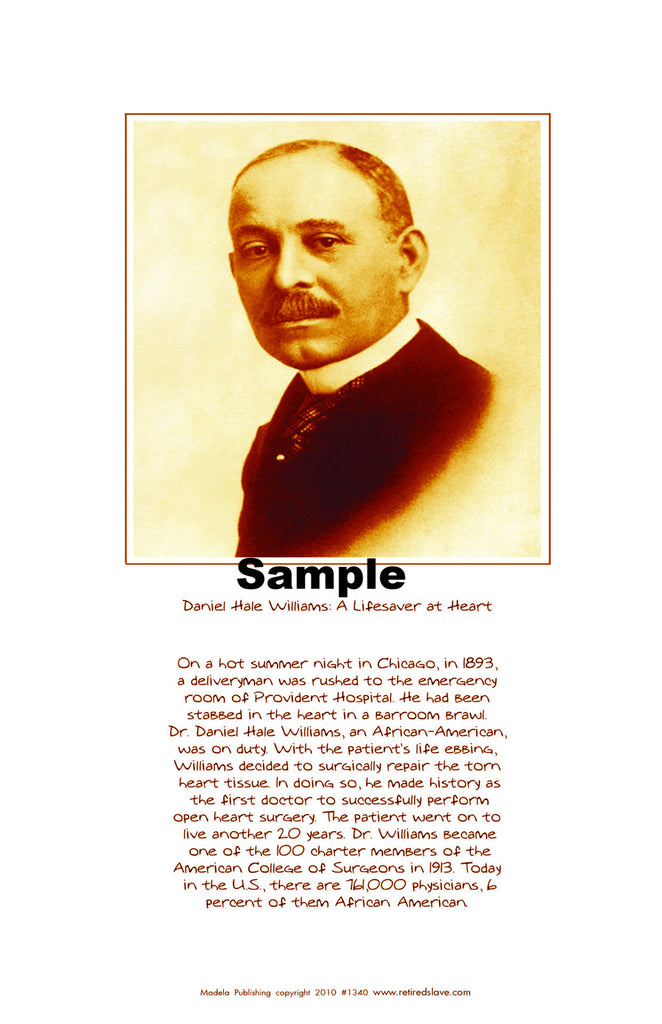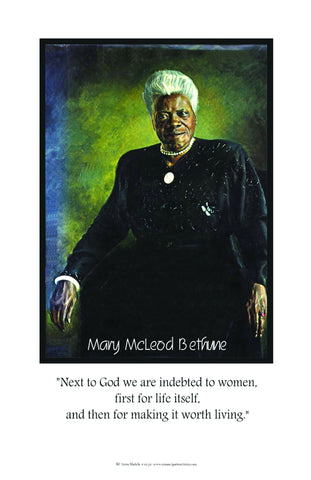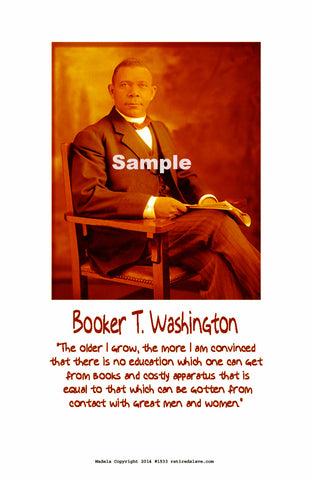Dr. Daniel Hale Williams #1340
$ 10.00
Caption from poster__
Daniel Hale Williams
A lifesaver at Heart.
On a hot summer night in Chicago, in 1893, a deliveryman was
rushed to the emergency room of Provident Hospital. He had
been stabbed in the heart in a barroom brawl. Dr. Daniel Hale
Williams, an African-American, was on duty. With the patient's
life ebbing, Williams decided to surgically repair the torn heart
tissue. In doing so, he made history as the first doctor to
successfully perform open heart surgery. The patient went on
to live another 20 years. Dr. Williams became one of the 100
charter members of the American College of Surgeons in 1913.
Today in the U.S., there are 761,000 physicians, 6 percent of
them African-American.
Dr. Daniel Hale Williams was an African American physician who made history by performing the first successful open heart surgery operation. Daniel Hale Williams was born in 1856 in Hollidaysburg, Pennsylvania, the fifth of eight children. His father was a barber who died when Daniel was only nine. His mother was unable to provide for all the children on her own, so she moved the family to Baltimore, Maryland to stay with relatives. An apprenticeship with a shoemaker was found for Daniel; he remained there as a shoemaker's apprentice for three years while he was still a young child. As a teenager, he learned to cut hair and became a barber, living and working with a family who owned a barber shop in Janesville, Wisconsin. In Janesville Daniel began to attend high school. He graduated from Hare's Classical Academy in 1877. While working as a barber, he met Dr. Henry Palmer, a leading surgeon, who became the Surgeon General of Wisconsin. Dr. Palmer took Daniel on as a medical apprentice; he had two other apprentices at the time. Dr. Palmer helped the three apprentices apply for admission to a top medical school, the Chicago Medical School, which was affiliated with Northwestern University. All three were accepted and began their studies in 1880. Dr. Daniel Hale Williams graduated with his medical degree in 1883. Dr. Williams began to practice surgery and medicine at the South Side Dispensary. At the same time, he held a position at Northwest University, as an instructor of anatomy. He worked for a time as a medical doctor for the City Railway Company and for the Protestant Orphan Asylum. Dr. Williams's practice began to grow, as did his reputation as a skilled surgeon. In 1883, he was one of only four African American doctors in the Chicago area, yet he gained so much respect within the medical community that six years later, in 1889, he was appointed to the Illinois Board of Health. Dr. Williams observed that African American patients were routinely subject to second-class medical care. Also, opportunities for most Black physicians were extremely limited, and it was difficult for African Americans to gain admission to medical and nursing schools because of institutionalized racism. Dr. Williams met a young woman, Emma Reynolds, who had been refused admission by every nursing school in the area. This prompted him to launch a new venture, the first African American owned hospital in the United States. It started as a twelve-bed facility, named Provident Hospital. At Provident Hospital, Dr. Williams also opened the first nursing school for African Americans, where Emma Reynolds and six others made up the first graduating class. Dr. Williams employed African American and White doctors at Provident Hospital, emphasizing the need to provide the best available care to everyone. He required that the doctors at Provident keep abreast of the latest advances in medicine. Two years later, in 1893, a young man named James Cornish was rushed to Provident Hospital with a stab wound to the chest. Doctors at this time did not have X-ray machines, and the doctors at Provident were unsure what to do for Mr. Cornish. His condition began to deteriorate; his pulse was getting weaker and he started to go into shock, which are signs of internal bleeding. In the operating room, Dr. Williams made the decision to open up Cornish's chest and see what could be done before he bled to death internally. The surgical team found a pierced blood vessel and a tear to the pericardium tissue around the heart. Dr. Williams sutured both of these injuries to stop the bleeding. James Cornish survived the operation. Newspaper headlines reported: "Sewed Up His Heart! Remarkable Surgical Operation on a Colored Man!" Cornish recovered and lived another twenty years. It was the first successful open heart surgery ever performed. Dr. Williams's medical career prospered and he became surgeon-in-chief at Freedmen's Hospital in Washington, D.C.. He organized the hospital into specialized departments such as Medical, Surgical, Gynecological, Obstetrical, Dermatological, etc. He helped organize the National Medical Association, which at the time was the only medical organization open to African Americans. In 1898 he married Alice Johnson, a school teacher, and moved back to Chicago where he acted as chief of surgery at Provident, which had grown to be a much larger institution. He continued on to hold top positions in teaching and as head surgeon at another Chicago hospital. Dr. Williams was often invited to speak to doctor's associations around the country on the subject of health care for African Americans. He encouraged African American leaders to open hospitals in other cities where African American people would receive first rate care. He received numerous honors and was the first Black physician named as a Fellow in the American College of Surgeons. In 1926 he retired after suffering a stroke. Dr. Williams passed away in Idlewild, Michigan, in 1931, after a life of history-making accomplishments.




